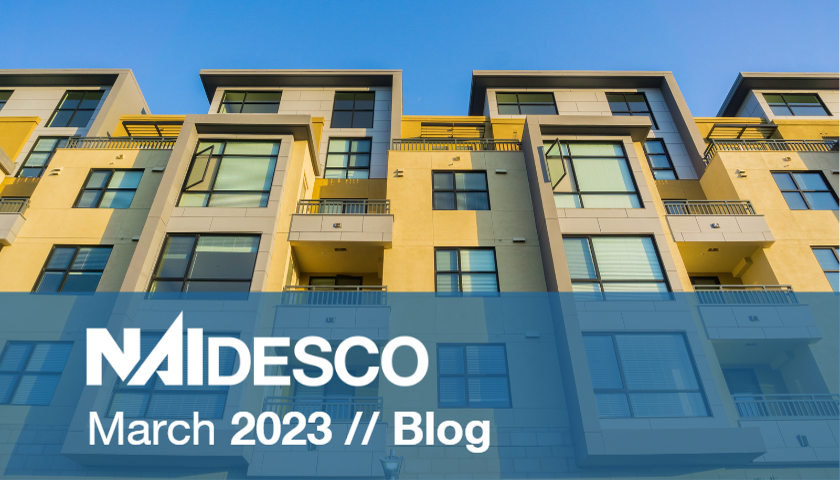NAI Global March 2023 Multifamily Roundup

March 2023 // NAI DESCO Blog
The March virtual meeting to discuss multifamily trends and market conditions with experts from various NAI Global offices in the U.S. featured more than a dozen participants and was moderated by Arthur Milston, Senior Managing Director and co-head of the Capital Markets Group of NAI Global. The following is a recap of the event and related trends impacting the multifamily market.
Highlights of What’s Currently Happening in the Multifamily Sector
One of the biggest issues impacting all real estate development since the pandemic started – regardless of product type, has been high construction costs – both in materials and labor. While anecdotal commentary from the boots-on-the-ground brokerage community asserts that labor prices remain stubbornly high, there appears to be some relief in the materials sector, starting with lumber. Just this month spot lumber prices were reported at $370 per thousand board feet. Looking back to September last year, lumber futures, a precursor of lumber prices, fell sharply for the second time in 2022, with lumber futures closing at $410.90 per thousand board feet, which is about where it was before the pandemic. A board foot is one inch thick, one foot wide and one foot long. In other words, lumber now costs less than it did in 2019.
The change is beginning to trickle down to new multifamily construction, with one of the meeting participants saying that townhome and condominium builders in their market are experiencing 5% to 8% cost relief in their projects. He also added that in one example, a client was looking at a project with preliminary estimates coming in at $300-per-square-foot to build, and when the client took it to hard bid, the price came down 10%. For multi-story multifamily construction, however, the price-per-foot is north of $400 in that meeting participant’s market.
Even so, many apartment developers are getting land entitled and permitted and then waiting to start construction, with some perhaps waiting indefinitely. One meeting participant said the combined cost of land, construction and associated infrastructure is so high “you would have to build it at a 9% cap rate to sell it at a 7% cap rate. Hence, one of the phrases of this current cycle—negative leverage.
Related, another meeting participant said that homebuilders are walking away from entitled projects with low confidence that the buyer pool would be willing or able to afford homes with current mortgage rates. One interesting factoid we have come across recently, on this note: for every 100-basis-point increase in a residential mortgage rate, that is the equivalent of a 10% price increase in the sale price of a house.
Fast-paced rental rate growth has stalled, with some markets even declining – Seattle, Boston, Las Vegas among them – by as much as 6% to 8%. If one were to take out the seemingly endless population growth stories in Dallas and Miami, rents are likely to be flat in most markets for the foreseeable future or rise moderately. Where employment remains elevated, rents will continue to grow, though modestly. In Silicon Valley, for example, rent growth will likely be around 4% this year.
Despite the turbulence, as Milston pointed out, “the long-term fundamentals for multifamily housing are unbelievably strong,” which all comes down to household formation, supply and demand. And demand is much stronger than existing supply. A recent housing report from the National Association of Realtors (NAR) asserts that the housing market is currently 6.5 million single-family homes short of population and household formation growth. According to NAR, from 2012 to 2022, there were 15.6 million household formations in the U.S., or nearly 2.1 million per year. In the same time frame, 9.03 million single-family homes were started, with 8.5 million completed in that 10-year span, while 4.2 million multifamily unit starts took place, with 3.4 million completions. Taken together, that is a 7.1-million-unit gap, or shortfall, in new housing supply.
New supply is on the way, however, with one brokerage firm forecasting that 716,000 multifamily housing units are set to be delivered over the next 24 months, and the national vacancy rate should rise from its current 4.6% to 5.2%. At the moment, there are approximately 750,000 multifamily units under construction – the most since the 1980s.
Multifamily investment sales are still largely on hold, with institutional product likely to be stuck in neutral for another six months. As previously reported, the gap between seller and buyer expectations has yet to close. The exception remains with smaller deals that sell for all cash or require little debt, as well as 1031 trades. The opportunities that could appear later this year and next, however, are with some of those projects that are under construction in which the developers started their projects with pro formas of an expected 4% take-out loan and when faced with borrowing rates that are around 7% now and could go to 8%, they may be forced to sell.
Thought Leaders
- Arthur Milston, NAI Global, New York, NY
- Jake Hallauer, CCIM, NAI Affinity, Fort Collins, CO
- Ryan Schaefer, NAI Affinity, Fort Collins, CO
- Alex Waddey, NAI Global, Nashville, TN
- Matt Connolly, NAI Iowa Realty Commercial, Des Moines, IA
- George Dikanarov, NAI FrontPoint Partners, Luxembourg
- Josh Rodstein, NAI Miami, Miami, FL
- Troy Reynolds, NAI G2 Commercial, Columbus, GA
- Berkeley Fergusson, NAI Dominion, Richmond, VA
- Wally Sauthoff, NAI Greywolf, Milwaukee, WI
- Scott Andrews, CCIM, NAI Nashville Stanton Group, Nashville, TN
- Kevin Kawaoka, NAI Capital Commercial, South (LA) Bay, CA
- Eric Blumenthal, MICP, NAI Elite, Hartford, CT
- Natasha Davis, NAI Northgate, Stockton, CA
- Samantha Bustamente, NAI Northgate, Sacramento/Stockton, CA
- David Eldredge, NAI Glickman, Kovago & Jacobs, Worcester, MA